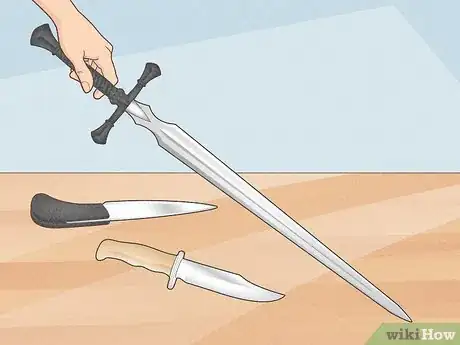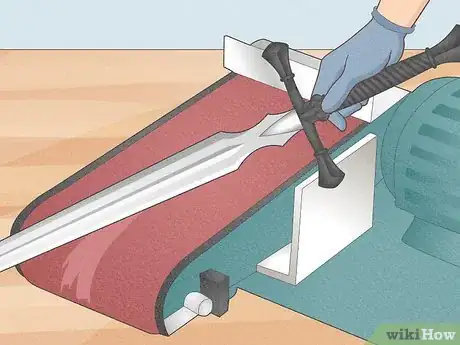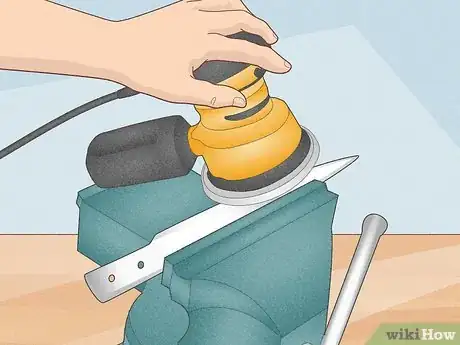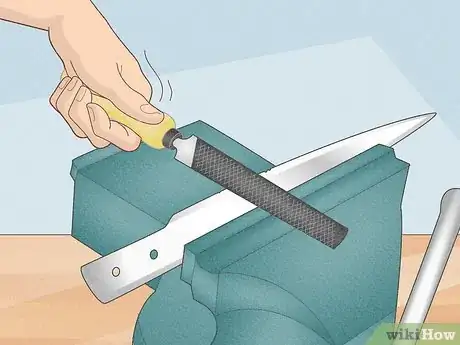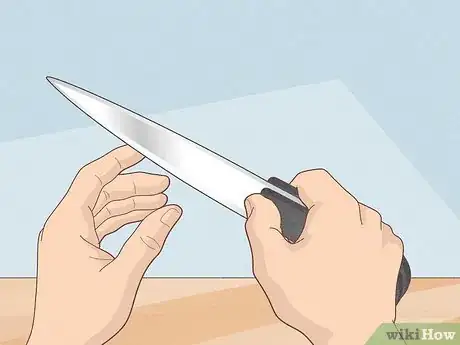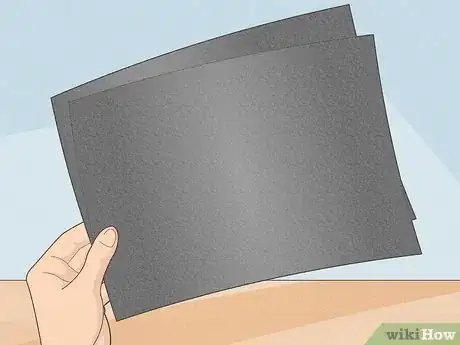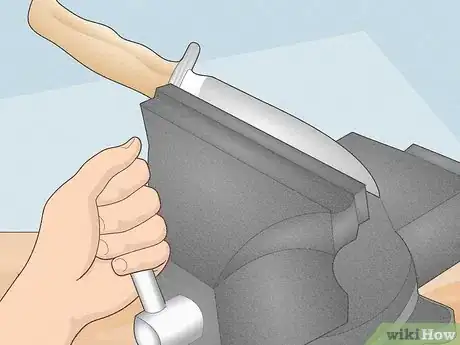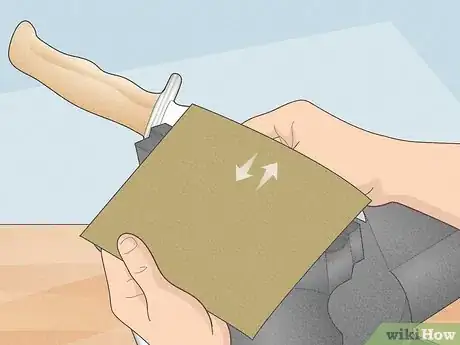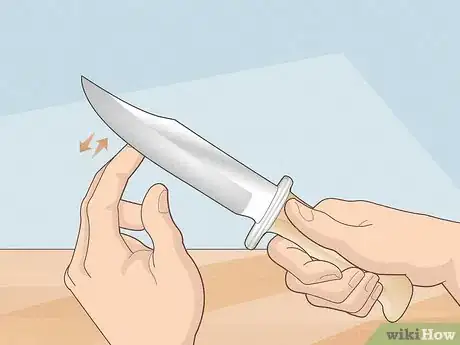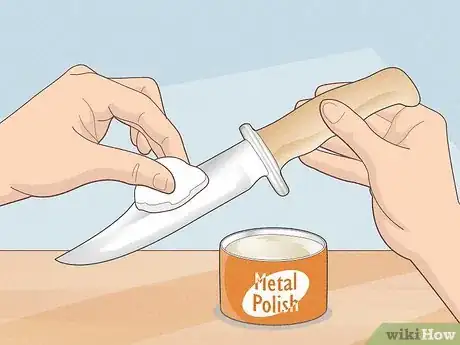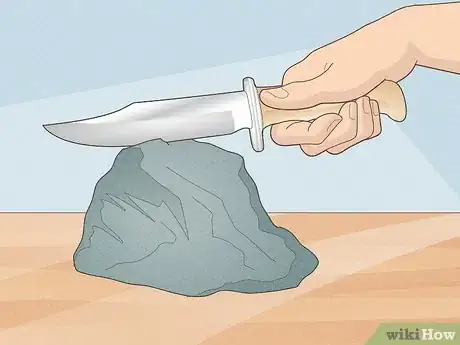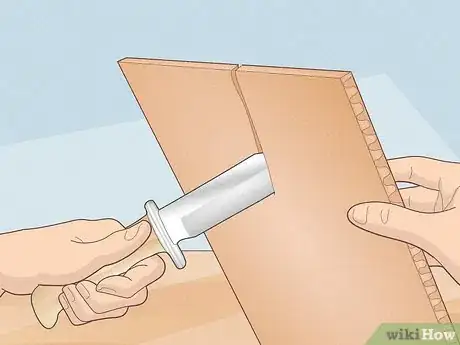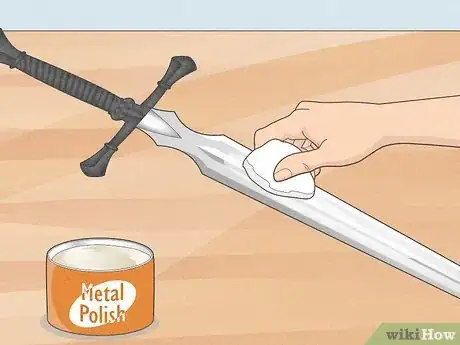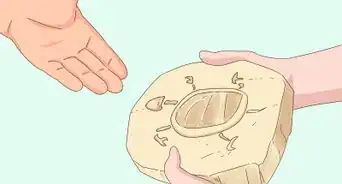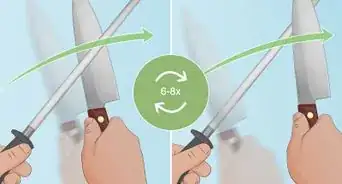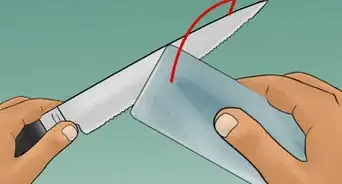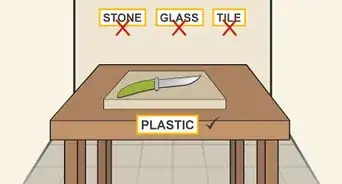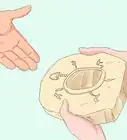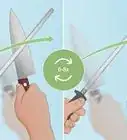This article was co-authored by wikiHow Staff. Our trained team of editors and researchers validate articles for accuracy and comprehensiveness. wikiHow's Content Management Team carefully monitors the work from our editorial staff to ensure that each article is backed by trusted research and meets our high quality standards.
There are 7 references cited in this article, which can be found at the bottom of the page.
This article has been viewed 94,769 times.
Learn more...
Although most people want their knives and swords to be as sharp as possible, there are times when a blunted blade is better. Blunting a blade's edges will rob it of its ability to cut. A blade will naturally blunt with regular use over time, so simply overusing it will result in the dull edge you're looking for. However, the same effect may be achieved more thoroughly by intentionally using of tools.
Steps
Blunting a Blade with a Sander
-
1Consider the type of blade you're blunting. Thinner blades are more delicate and will require gentler tools to effectively blunt them. Thicker blades, on the other hand, may be dulled with heavier tools without as much worry about damage.
- Generally speaking, you should use manual techniques for long, flimsy, and thin blades. Sanding machines work best for the larger ones.[1]
-
2Select the sander for your blade. An industrial belt grinder is the most effective, but a heavy belt sander can also work. You may want to consider using an orbit sander, as these are common tools and will be easier to control than a belt sander.[2]
- Regular sandpaper may tear or lose its grit easily when dulling a metal blade. Emery can be used, but silicon carbide or aluminum oxide paper is preferred in a relatively coarse grit, like 40 or 50.
Advertisement -
3Grind the blade edge at an angle for stationary sanders. Wear gloves and a mask to prevent metal shaving from harming your hands and eyes. Be sure the belt of the sander is running away from you. This way, if you lose your grip on the blade, it isn't launched in your direction. Then:
- Position the blade above the top of the running sander. Slowly turn the blade into the sanding belt, so tip of the edge of the knife descends to the belt.
- Keep a firm hold of the knife, so the motion of the belt doesn't fling the knife from your hand. Allow the sander to run against the tip of the knife to blunt it.
- Alternate sides of your knife, so that your blade is dulled regularly on each side. Be careful when switching sides that your clothing does not get caught in the sander.
- The motion and the angle of pressure you use with your knife will feel like you are folding the tip of the edge of the blade over.[3]
-
4Use a vice for hand operated power sanders. If using a handheld sander or sandpaper to dull your edge, you should clamp your knife extremely tightly in a vise. You may want to remove the knife from its casing so that you can clamp the entire blade in the vise. A loose clamp may result in the knife flying free and doing harm or damage. After the knife is secured:
- If you have a directional sander, make sure the belt is running away from you. This way, if the blade comes free of the vise, there's less chance of personal injury.
- Slowly lower your sander to the tip of the edge of the blade. Try to approach your blade on a slight angle.
- Alternate sides of the blade. It may take some time before you notice your edge start to blunt.
- Much like using a stationary sander, this motion will feel like you are folding over the tip of the edge of the blade.[4]
-
5File your blade to remove burrs and irregularities. While blunting your blade, it's likely that small burrs in the metal have formed. In some cases, slight imperfections may have formed during the dulling process. Run your file back and forth over both sides of the blade to remove burrs, shavings, and smooth the finish of the blade.
- If you notice visible irregularities in the metal, you may want to pay special attention to these spots with your file until the knife looks regular and smooth.
-
6Test the sharpness of your blade and polish. Run your finger perpendicular to the blade so it brushes against the metal left to right and right to left of the blade. Use caution when doing this. It's possible that you missed a spot while dulling the blade, and you could cut yourself if you're not careful. If the blade has dulled acceptably, use a dab of metal polish to restore the blades appearance. [5]
- If the blade still feels sharp, it may need another pass with the sander. You may need to replace your sandpaper several times during this process, especially if you have to perform this procedure several times.
Hand Blunting a Blade
-
1Select your sandpaper. Energy can work for dulling, but aluminum oxide and silicon carbide are best suited to hand blunting your blade. You'll want to choose one that has a coarse grit between 40 and 50. The coarse grade will remove the edge of your blade faster.[6]
- There may be some specially formulated sandpapers available at your local hardware store. You should inquire with staff about a coarse grit paper suited for taking the edge off metal.
-
2Put your knife in a vise. Holding onto your knife while trying to sand by hand could cause you to slip and cut yourself. Using a vise to hold your knife securely in place is the safest method to hand sand a blade. Be sure the knife is firmly secured, with the blade pointed upwards.
- You should avoid leaving your knife in the vise unattended. Even if it only takes you a few days to blunt your blade to the point you desire, someone could trip and cut themselves on the work in progress.
-
3Blunt the blade. Take each end of your sandpaper in your hands and hold it over the edge of the blade. Lower the paper until you feel the blade pushing gently up against it. Using firm outward pressure and slight downward pressure, run the paper back and forth over your blade.
- Be careful not to apply too much pressure to your paper. Doing do can cause the knife to cut the paper.
- Depending on many factors, like the kind of metal your blade is made of, the kind of sandpaper you're using, the age of the blade and more, it may take some time before your blade becomes blunt.
-
4Gauge the blade's dullness with your finger. Use caution when doing this, your blade may still be sharp enough to cut. Throughout the dulling process, you should periodically check your blade by running your finger across it crosswise. Never run your finger along the edge of the blade. Once it reaches the your desired level of dullness, you hand dulling is complete.[7]
- Be sure to test the entire length of the blade. You may have applied uneven pressure to your sandpaper, which could have resulted in uneven dullness.
-
5Polish the blade. After you have dulled the blade sufficiently, apply a coat of metal polish to the blade. Dab the polish on a piece of cloth and apply it to the blade from top to bottom. This will restore the the appearance of your now dull blade.
- Polishing your blade after dulling is especially important if you've dulled the blade for use as a household ornament.
Blunting a Blade Naturally
-
1Wear the blade down with regular use. Blades wear down naturally over time. The more you use your blade, the duller it will become. If dulling a blade is your goal but you feel uncomfortable using a sander to dull it, you should make an effort to use the tool as much as you can.
- Harder and thicker objects will cause the blade to blunt most quickly. For example, you might cut kindling for fires with the sword you are trying to blunt.
-
2Draw the blade against a harder object. This is another blunting technique that is similar to using a whetstone. By dragging a blade against a whetstone, you sharpen it, but by dragging a blade against a hard surface, especially a coarse one, you'll cause the blade to lose its edge.[8]
- You might consider using a rock, cinderblock, or a piece of metal. This can be very effective with smaller blades, and you can even do this as you watch TV.
- Be careful when performing this dulling technique. It's easy to lose your grip on the knife or to drop it and potentially hurt yourself.
-
3Drag the blade against or cut cardboard. Cardboard is a perfect household item you can use for blunting a blade's edge. Scrape the point of the blade's edge against cardboard repeatedly, checking the sharpness with your finger every so often to gauge your progress.
- You can also use your blade to cut cardboard to receive the same dulling effect. This way, you can blunt your blade while disposing old boxes.[9]
-
4Polish your blade after blunting it. Apply some polish to a cloth and coat your blade with it after you've blunted it sufficiently. This will rejuvenate the blade's appearance and make it look sharp again in spite of being dulled. Now you can display your blade without fear of it causing harm.
Community Q&A
-
QuestionIn which direction should I sharpen a knife or a sword?
 Community AnswerWhen sharpening a knife or a sword, start at the hilt and move towards the tip of the blade.
Community AnswerWhen sharpening a knife or a sword, start at the hilt and move towards the tip of the blade. -
QuestionCan cutting cheese blunt a knjfe blade?
 Community AnswerOnly if you are using it on a cutting board made of anything other than plastic or wood. If you knife is not making a mark on your board, your board is making a mark on your knife. So, if you are using a glass, ceramic, metal, or stone board (which is not uncommon for cheese boards), and are using a traditional sharp knife instead of a cheese knife, it will dull your knife blade.
Community AnswerOnly if you are using it on a cutting board made of anything other than plastic or wood. If you knife is not making a mark on your board, your board is making a mark on your knife. So, if you are using a glass, ceramic, metal, or stone board (which is not uncommon for cheese boards), and are using a traditional sharp knife instead of a cheese knife, it will dull your knife blade.
Warnings
- Especially when using a machine to blunt your blade, the pressure on it could cause the blade to shatter. This can cause injury.⧼thumbs_response⧽
- False edging a blade can devalue it if it is a collectible item. Keep this in mind if you may want to resell it in the future.⧼thumbs_response⧽
References
- ↑ https://www.theknifeconnection.net/blade-grind-types/
- ↑ http://www.popularmechanics.com/home/tools/reviews/a3118/know-your-power-sanders-and-how-to-use-them-13314160/
- ↑ http://www.buckknives.com/pdf/WEBKnifeSharpeningDocument.pdf
- ↑ http://www.buckknives.com/pdf/WEBKnifeSharpeningDocument.pdf
- ↑ http://indefinitelywild.gizmodo.com/how-to-sharpen-any-knife-1641292517
- ↑ http://www.lowes.com/projects/woodworking-and-crafts/sandpaper-buying-guide/project
- ↑ http://indefinitelywild.gizmodo.com/how-to-sharpen-any-knife-1641292517
- ↑ http://www.thearma.org/essays/damagededge.htm#.V2GZxbsrLIU
- ↑ http://www.ammoland.com/2009/05/sharpen-knives-with-cinder-block-and-cardboard/#axzz4BgDNhobt
About This Article
To blunt a blade, start by getting some coarse-grit sandpaper. Then, securely fasten your blade down, using either a vise or another device so the blade doesn’t move around and injure you. Next, begin running sandpaper over the blade, using firm outward pressure and slight downward pressure. While you’re sanding down the blade, periodically run your finger along the top of the blade to check its sharpness. This process might take quite a while, so be patient, since rushing could cause accidents. For some other household items you can use to dull your blade, keep reading!
